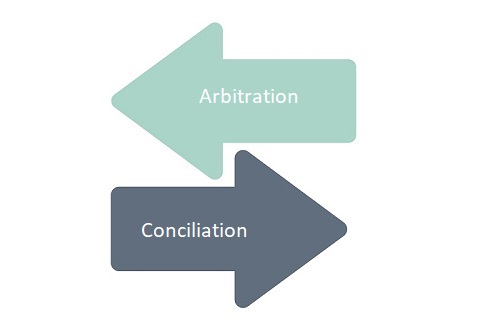Arbitration and Conciliation Difference – One Sentence
The Arbitration and Conciliation Act, 1996.This law was created in India to give people and businesses a better way to settle disputes without going to court. Instead of long, expensive legal battles, the Act allows people to solve problems through arbitration (like a private judge) or conciliation (a peaceful way to talk it out).
Arbitration and Conciliation Difference
| Aspect | Arbitration | Conciliation |
|---|---|---|
| What it is | A method where a third person (arbitrator) listens to both sides and decides. | A method where a third person (conciliator) helps both sides talk and agree. |
| Third party’s role | Makes the final decision like a private judge. | Just guides the parties to reach their own agreement. |
| Decision power | The arbitrator gives a decision that both sides must follow. | The conciliator does not give a decision — the parties decide together. |
| Formality | More structured, with set rules and procedures. | More relaxed and informal process. |
| Who controls the result | The arbitrator has control over the final outcome. | The people in the dispute have control over the outcome. |
| Enforceable? | Yes, the decision (award) can be legally enforced. | Only if both parties agree and sign a settlement, then it may be enforceable. |
| Best for | Business or legal conflicts where a clear decision is needed. | Personal, workplace, or softer disputes where cooperation is possible. |

Arbitration and Conciliation Difference
Arbitration
Arbitration is a method of resolving conflicts where the people or groups involved agree to let a neutral third party, known as an arbitrator, make a decision instead of going through the court system. This process is commonly used when there is a disagreement, often in business or legal contracts, and both sides want a quicker and more private way to settle the issue.
In arbitration, each side presents their side of the story, shares any documents or evidence, and may even bring witnesses, just like in a courtroom. The arbitrator carefully listens to both sides, asks questions if needed, and then makes a decision based on what they’ve heard. This decision is usually final and legally binding, which means both parties must accept and follow it.
One of the key benefits of arbitration is that it’s often less formal, less expensive, and faster than going through a traditional trial. It also keeps the dispute confidential, which can be important for sensitive matters. However, since the decision is typically final, there’s very limited chance to appeal if one party disagrees with the outcome.
Conciliation
Conciliation is a way to settle disputes where a neutral person, called a conciliator, helps the people or groups in conflict talk things through and find a peaceful solution. Instead, their job is to guide the conversation, clear up misunderstandings, and suggest possible solutions that both sides might agree on.
This process is often more relaxed and informal than court or arbitration. The goal is not to declare who’s right or wrong, but to help both parties reach an agreement they’re both okay with. The conciliator may meet with both sides together or separately, and they try to create a friendly, respectful environment so the discussion stays calm and productive.
Conciliation is used in many areas, like workplace disputes, family disagreements, or community conflicts. It’s useful when people want to preserve their relationship or just avoid the stress and cost of going to court. Since the outcome is based on mutual agreement, both sides usually feel more satisfied with the result.
Arbitration and Conciliation Difference
1.Decision Authority
-
Arbitration: The neutral person (arbitrator) listens to both parties and makes a final decision that everyone must follow.
-
Conciliation: The neutral person (conciliator) does not make decisions—they help both sides talk and find their own agreement.
2. Outcome Control
-
Arbitration: The outcome is decided by the arbitrator, not by the people involved.
-
Conciliation: The outcome is controlled by the parties—they choose whether to accept any solution.
3. Formal Process
-
Arbitration: It’s more formal, often similar to a court case, with rules and structured steps.
-
Conciliation: It’s informal and flexible, focused more on discussion and understanding.
4. Type of Result
-
Arbitration: Ends with a judgment—there is usually a clear winner and loser.
-
Conciliation: Aims for a mutual agreement, where both sides feel satisfied.
5. Style of Communication
-
Arbitration: More like a legal procedure—evidence, facts, and rules matter most.
-
Conciliation: More like a guided conversation—trust, compromise, and dialogue matter more.
6. Common Use
-
Arbitration: Used in business contracts, employment issues, and legal matters needing final decisions.
-
Conciliation: Used in personal, family, or workplace problems, where people want to solve things peacefully.
In Short:
-
Arbitration: Someone else makes the decision for you.
-
Conciliation: You work together to find your own solution—with help.
